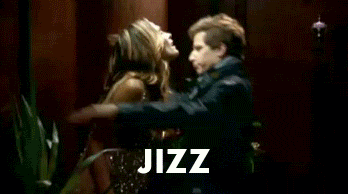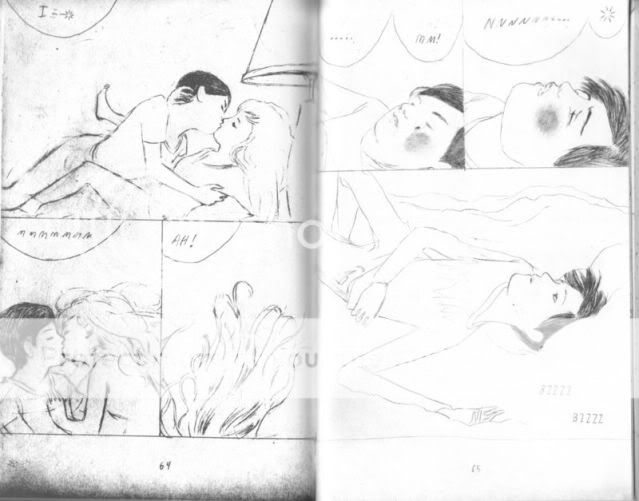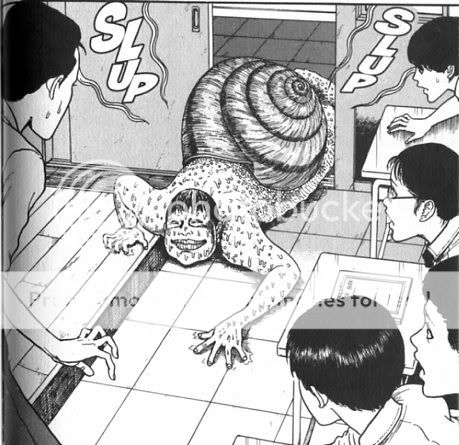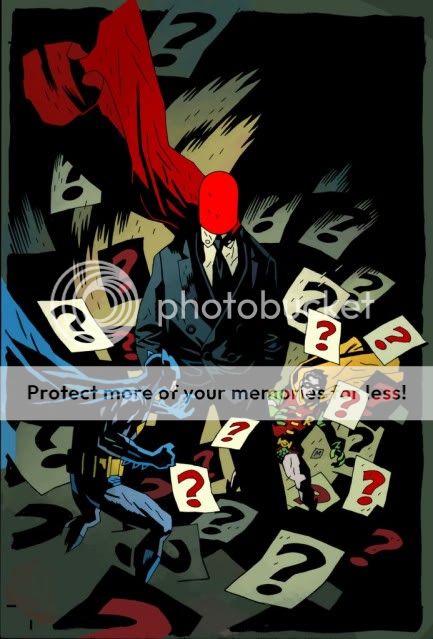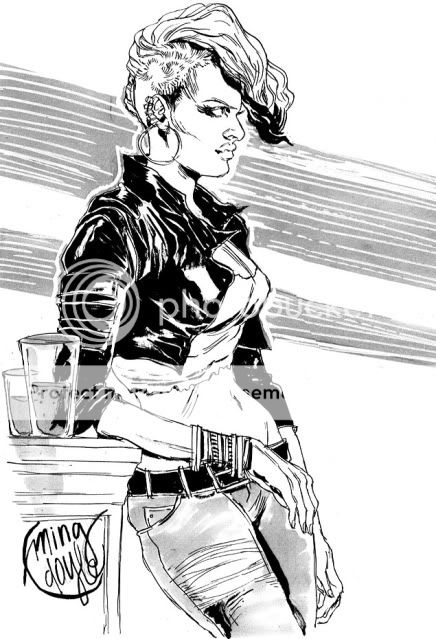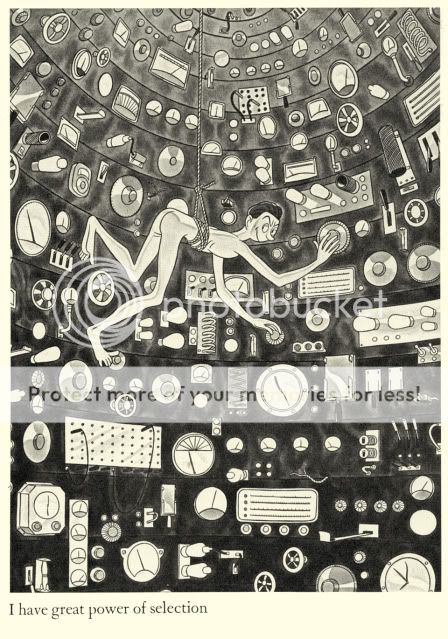Archive for May 18, 2010
Lost thoughts
May 18, 2010S
SP
SPO
SPOI
SPOIL
SPOILE
SPOILER
SPOILER A
SPOILER AL
SPOILER ALE
SPOILER ALER
SPOILER ALERT
* This was pretty much the episode that the people who didn’t like last week’s episode wanted instead: Following the various bands of characters around as they drop exposition on one another on their way to getting where they need to be, physically and mentally, for the finale. Indeed, I’ve already seen a couple of things from nerd-friendly mainstream-media people that indicate, in spoiler-free fashion of course, that this was a whoo-boy episode for them.
* Me? Other than voicing my sinking suspicion that I’m never gonna see Walt again goddammit, I don’t have a ton of stuff to say about this episode. As a discreet, hour-long unit of television, I prefer last week’s intensely acted, emotionally violent, “Long ago there were two sons” creation fable. Now, obviously at this point in the show, and for several earlier seasons besides, none of these episodes are really just a discreet, hour-long unit of television, so that’s probably neither the fairest nor the most germane standard to hold it to. Still, that’s where I’m at.
* So what did I like about it? The violence, mainly. Not ashamed to say it! I’ve written about the appeal of violence on the show before–I remember mentioning it in my thing a few things back about how I like this show as a narrative genre drama, and all that entails, rather than as some kind of elaborate crossword puzzle. But I think it was last week’s episode that really crystalized that this is a show about violence as much as anything this side of Deadwood. With a few exceptions, it’s about how the Island took people who’d made choices that hurt people emotionally, or fallen victim to choices that hurt them emotionally, and gave them choices that could lead them to hurt people or be hurt physically. It’s about murder as much as a superhero comic is about the big fight with the supervillain. In this case the supervillain is the Monster, and watching him murder his way through Richard and Zoe in no-nonsense split-second fashion now has all the weight of that shot of the Man in Black gripping his game box in the middle of his leveled village and seething with insane rage.
* Plus, Ben finally gave Widmore his comeuppance. Because this show is rivaled only by Gossip Girl in its infatuation with characters who lie all the time, I’ve got no idea whether we can believe a word Widmore said in this episode regarding turning babyface, but I did at least think he and Ben would forge a tenuous alliance. I thought so right up until the moment Ben apologized to Widmore for leading the Monster to him–I really assumed Ben had quickly conspired with Widmore to lead Fake Locke into a trap and blow him up with the C4 or something. Anyway, I think the presence of the Monster sort of distracted from the potentially epic feel of a final Ben/Widmore showdown, but in a way, that’s probably how it should be. Ben’s not an epic-confrontation kind of guy. He’s more a “shoot him repeatedly when he’s not looking” kind of guy. As with Widmore’s supposed switch to the side of the angels, I have no idea if Ben’s (presumably final) heel turn is for real or a ruse, but that’s certainly the fun thing about Ben.
* Well, it was Jacob’s cave, how about that.
* Hey, wait a minute, Fake Locke got Ben on board (maybe, at least in theory) by promising him the Island. But our cliffhanger ending was Fake Locke telling Ben he’s going to destroy the Island. If I were Ben I’d get nervous at this point, especially standing right next to that well.
* One thing I’ll say for all the chess-piece movements in this episode is that the final confrontation ought to be fairly clear-cut at this point, simply because there are so few people left. You’ve got Ben and the Monster, you’ve got Jack and company, and Miles and Desmond and Claire are out there someplace. I suppose there are still Widmorian scientists on Hydra Island, but I can’t see that making much of a difference.
* Sinister Sideways Omniscient Desmond is a scream. Man, he took Dr. Linus down like wo. It was nice of him to involve Ana-Lucia, although I was hoping for Mr. Eko.
* Sideways Rousseau cleaned up good! Love her love connection with Ben.
* I wanted to write out a couple of things here because I can’t remember if in the past I’d only written them in comment threads. First, everyone convinced me last week that I was wrong about the Monster’s origin–it’s not just some independent Monster mimicking the Man in Black, it’s the Man in Black trapped in Monster form. That was confirmed by Jacob last night, so good call, everyone.
* Second and most importantly, I no longer think that the flashsideways characters will have to choose to sacrifice their happy lives in order to stop the Monster in the real reality. I think their happy lives are their reward for having stopped the Monster in the real reality. The flashsidewayses are the show’s happy ending. Sideways Desmond’s mad scheme to show everyone the other reality isn’t an attempt to get them to relinquish the sideways reality, it’s a way of drawing their memories of their Island-influenced lives into their current lives, so that all of that will still matter, but now they’ll be able to move past it.
* Why could no one on the Island have babies? Why was Walt a big deal? Why did the Others act like murderous assholes all the time if they were working for semi-benevolent Jacob? Why did Ben and Widmore have their falling-out? What was up with the Cabin, the Temple, Dogen, the ash, and other apparent Monster-containment devices? Will the elusive #108 ever show up, or was that just Desmond all along? What were the rules that bound Jacob and the Monster, or Ben and Widmore, and were they really rules that couldn’t be broken, or were they more of a guideline than a rule in the grand Venkman tradition? See you Sunday!
Carnival of souls
May 18, 2010* Recently at Robot 6:
* Wizard ends it Charge of the Big Apple Brigade against the New York Comic Con but still schedules shows around it sniper-style;
* storybook drawings of R-rated movies;

* and three art-heavy reviews I liked a lot. Hmm, I wonder what it says that I liked these reviews in large part because of their well-chosen art, but virtually never include art in my own reviews. I think it mostly says that scanning is time-consuming and there are no scanners on the Long Island Rail Road.
* Hey, it’s a movie about a British Cold War-era submarine getting attacked by a giant squid. Apparently. It’s all rather oblique. Still, you know me and sea monsters. (Via Topless Robot.)
* Until you’ve bought and used a lawn mower on your own yard, you’ll never understand.
* Only two more episodes to go, so please check out last week’s Lost thoughts and then join us tonight for more!
Quote of the day
May 18, 2010[Noah Berlatsky:] I basically agree that saying, “Well, Clowes’ character shouldn’t talk about Dark Knight because Clowes was involved in a lousy movie,” seems ridiculous. I do have some sympathy with the irritation Abhay expresses. Which is, there’s a default stance in certain regions of lit comics land which is basically: “life sucks and people are awful.” Which I think is glib and overdone and tedious, a, and which, b, can be made even more irritating by the fact that the people promulgating it are, you know, fairly successful, and (what with various autobiographical elements thrown in) the result often looks like a lot of self-pity over not very much.
So…I’m wondering how strongly you would push back against that characterization of lit comics in general…and also whether you feel it is or is not ever appropriate to think about a creator’s biography in relation to his or her work in that way.
[Tom Spurgeon:] At this point I wouldn’t push back at all against the stance that says the default mode in lit comics land is basically “life sucks and people are awful” because it’s no longer an argument I take seriously. I don’t think it’s true by any reasonable measure and I’m done with entertaining the notion until someone presents the argument in a much more effective or compelling fashion than what always sounds to me like some angry, lonely, re-written Usenet post from 1997.
Smash the control images, smash the control machine
May 17, 2010Honestly? I made a point of going to see the restored, virtually complete edition of Fritz Lang’s Expressionist science-fiction masterpiece Metropolis at least in part because I saw freaking Clash of the Titans in the theater. It always bothers me when I come across a comics blogger of obvious talent and intelligence who nevertheless limits himself to writing exclusively about new genre releases from mainstream publishers; why should I settle for being that comics blogger’s cinematic equivalent? Iron Man 2 can wait; Iron Maria calls.
I’m glad I went. This thing’s a hoot and a half. After watching its two and a half hours’ worth of dystopian retro-future allegory, I’m at a loss to tell you how many of its seminal images I’d half-remembered from seeing the truncated version back in college versus how many of them had simply been passed down through films and film buffs across the decades like tablets from on high. It strikes me that the achievement of Lang, writer Thea von Harbou, cinematographers Karl Freund, Gunter Rittau, and Walter Ruttman, and a small army of designers and special effects technicians is not at all dissimilar from the mad inventor Rotwang whose mechanical seductress brings the stratified society of the titular city to collapse, or from the ancient builders of Babel whose titanic Tower serves as the movie’s allegory-within-an-allegory. Not that Lang and company’s creation lead to disaster, of course, but simply that they used all the tools at their disposal to bring a product of imagination to life. Metropolis is nothing if not a monument to imagination.
There’s an almost Kirbyesque quality to the images here, a carved-from-the-heavens-themselves feel that gives you a frisson of awe and familiarity when you see the most memorable of the lot. The back-and-forth movement of the workers at their posts. The vision of the factory as a pagan idol devouring human sacrifices. That unforgettably pointless-looking task of frantically moving the hands of the giant dial to and fro. A frightening tableau of the Seven Deadly Sins, with Death at the center, staring the camera down. The unmistakably feminine Machine-Man rising from her pentagram-bedecked slab, her hips swaying erotically. My personal favorite this time: The nightmarish vision of an underground city illuminated solely by gigantic banks of florescent lights in what passes for its sky–as relatable and horrible a vision of a workaday hell as you could likely conceive. It’s the kind of stuff that doesn’t even feel like the countless filmmakers and artists who’ve subsequently referenced it are ripping it off–they seem like transmissions from the collective unconscious. It shows you things you’ve never seen before, even if you’ve seen them a million times.
I think a lot of credit also must be given to the actors. That’s sort of a weird thing to say of silent cinema, where generally speaking we sort of overlook the dated, hammy acting style in favor of the image, or the message, or what Film X says about Weimar Germany or what have you. But Metropolis is at its most alive when the frame is filled with lead actress Brigitte Helm in her dual role as a saintlike activist and her sinister, leering robot doppelganger. In the former role, her fundamental goodness is driven home by the sort of unselfconscious close-ups no one really does of actresses anymore except maybe David Lynch; it’s easier than you’d think to believe that one look at her as she crashes the upper class’s private Garden of Eden with the children of the proletariat is enough to send scion of privilege Freder head over heels and love and cause him to upend his entire heretofore unexamined worldview. But it’s as the robot Maria that she really lights the screen on fire: She’s a winking, grinning, laughing, writhing, clutching, oozing, convulsing parody of female sexuality at its most wanton. Whether she’s vamping it up in pasties for a hilariously horndog audience of aristocrats or going the full Mrs. Carmody and whipping the enraged workers into a killcrazy frenzy, you can’t take your eyes off her–and indeed, the film frequently depicts her audience as nothing but a sea of swaying eyes, riveted on her every wriggle. It’s some for-the-ages stuff.
Gustav Frohlich’s Freder has a tough act to follow in that regard, and he’s more what you might expect if you’ve seen any silent movies, but I think his fits of ecstasy and agony–that’s basically the only two settings he’s got–properly convey that he’s a good soul caught up in a corrupt system and genuinely, if naively, wants to change it. His father, played by Alfred Abel, is far more fascinating a figure than you might expect: He does the steely captain of industry thing, but there’s something sad-eyed about him, as though his inhumane system has seeped into his pores and slowly poisoned him; he looks like a cross between Peter Cushing and Nestor Carbonell.
In terms of the added material, recognizable by its scratchier grain and smaller aperture, the standout stuff is the addition of a pair of subplots. The first involves Georgy, the worker with whom Freder, changes places in order to gain entry into the world of the workers; and the Thin Man, a strikingly lupine spy/enforcer sent by Freder’s father, city honcho Joh Fredersen, to keep Freder under wraps. Though it never really matters much in the grand scheme of things, Georgy’s abandonment of Freder for the lure of the red-light district available to the rich and the Thin Man’s menacing treatment of Freder’s confidant Josaphat add a further look at the decadence of Metropolis’s ruling class and another entry in the film’s series of standout performances via actor Fritz Rasp respectively.
The second added subplot gives an almost Lost-like wrinkle to the partnership-cum-rivalry between Fredersen and Rotwang. When Fredersen visits Rotwang’s lair to suss out his workers’ potential plans for revolt, he stumbles across an eerie shrine to his own late wife Hel. Rotwang believes Fredersen stole her away from him and resents him for siring the son, Freder, whose birth caused Hel’s death; in the end, Maria’s rampage, whatever its allegorical significance in terms of Fredersen’s desire to create an agent provocateur as a pretext for moving against the workers, was really an attempt by Rotwang to double-cross Fredersen and bring the whole city crashing down–revenge writ large. Some of this material was present in the original version, but the Hel statue and its attendant dialogue give it new force. The subplot further drives home the movie’s repeated motif of how the sins of the parents are visited upon the children, from the decadent Club of the Sons where the patriarchs’ spoiled trust-fund babies make sport to the climactic flood that almost wipes out the children of the absent, rioting workers.
That big flood climax gets a lot of added material in the restoration too, and that’s actually a shame; the most striking visual there, that of saintlike activist Maria rallying the children to her as the flood waters surround them, was already present, so most of what you’re getting here is just extra shots that drag out a fairly quotidian action spectacle. It’s not until things get mano a mano again–the workers capture the false Maria and she’s burned at the stake, laughing all the while; Rotwang captures the real Maria and forcers her up the stairs of a cathedral bell tower, where her attempt to escape leads to a run-in with the giant bell far above the ground that I found frightening even today; and Freder and Rotwang duke it out on the roof of the cathedral as his now-repentant father looks on in horror–that the film recaptures its mythopoetic mojo. Even if the ending is infamously idealistic and unrealstic–which it is, eliciting chuckles from pretty much any given audience–it too feels like something told around a campfire rather than whipped up to boost UFA’s bottom line.
And none of this is to say that the film’s self-serious. It takes itself seriously, yes, but it’s also very funny. You have to love the way the Maria-bot ends up being used: “Okay, we’ve created this lifelike simulacrum of our enemy in order to replace her with it and destroy her cause forever–but first, ROBOT STRIPTEASE!” I’d imagine Freder’s insouciance and Mariabot’s vampiness were funny to the audiences of the day just as they are to us. And even though the workers’ characterization as a barely controlled force of nature is unflattering to their half of the Marxist equation just as the upper crust’s characterization as the “Head” is unnecessarily complimentary, it’s still darkly entertaining to watch them rage, revel, and then rend their garments in despair at regular intervals.
You shrug off the slow parts and revel in the grandeur, to the sounds of a score by Gottfried Huppertz that references everything from Dies Irae to the Marseillaise. It’s a big, beautiful, intoxicating movie.
Great job!
Carnival of souls
May 17, 2010* Here’s a fine Charles Hatfield piece on Blaise Larmee’s lovely Young Lions, strategically illustrated in case you want to see whether this is your kind of thing.
* Speaking of strategically illustrated reviews, you’ve gotta check out Noah Berlatsky’s piece on Junji Ito’s Uzumaki. He takes the Men, Women and Chainsaws stuff a little far for my tastes–I guess it shouldn’t surprise longtime readers of mine that I might feel that way–but any art-heavy close reading of that unbelievably creepy snail sequence is worth your time. (Via Brigid Alverson.)
* It’s been way too long since I saw In a Lonely Place. I’ve got a copy on VHS someplace, I know…
* I know the feeling Tom Spurgeon’s talking about in his piece on the coming Big Two digital-comics apocalypse. I’ve got an interest in following superhero comics on a monthly basis but very little in buying them in serialized installments, so timely digital release of the weekly books with a subsequent release in trade paperback would siphon money out of me without breaking a sweat. I’m sure I get way too caught up in “Why haven’t they put their comics for sale online yet? Don’t they see what happened to the music industry???” and pay way too little attention to “For all its flaws, the Direct Market is what keeps the industry afloat–I sure hope the advent of digital comics doesn’t wipe it out!!!”
* Elsewhere, Tom reviews the Alex Ross art book Rough Justice. It’s a good review to read if, like Tom, you’re sort of on the outside of the Alex Ross Phenomenon looking in, or if you like books named after surprisingly good late-period Rolling Stones songs.
* Johnny Ryan gets scarier and scarier.
* Speaking of scarier and scarier, god only knows what Josh Simmons cooked up for the latest Cinema Sewer and Sleazy Slice.
* A preview of Ross Campbell’s Shadoweyes! You know what? I’m not 100% sold on this style–not the figurework so much as the way the direct-to-tablet art looks. We’ll see.
* A Mike Mignola Batman variant cover? Sure, I’ll eat it.
* A list of Metropolis-indebted movies with no Tim Burton Batman? For shame, Matt Zoller Seitz, for shame.
* Recently on Robot 6: How the heck did the Red Hulk use Thor’s hammer?;
* and superheroes and atheism, two great tastes that might taste a little weird together, when you think about it.
Comics Time: Trigger #1
May 17, 2010Trigger #1
Mike Bertino, writer/artist
Revival House, April 2010
24 pages
$5
They don’t make ’em like this anymore. Time was, a fella could stand in the aisle of one of your better comic book shops and watch one-man staple-spined anthology series like what Mike Bertino’s Trigger #1 augurs roam the countryside in huge horizon-spanning herds, from the halcyon days of Eightball and Optic Nerve to outliers like Rubber Necker and Uptight. Now, Buenaventura Press’s quixotic damn-the-torpedoes efforts aside, the format is the provience of minicomics and micro-publishers. And bless ’em, because as seen here, it’s a useful format.
Bertino puts himself through the paces with three comics done in three different tonal and artistic styles. First up there’s a literary-fiction young-professional thing about a teacher’s first day with a new class. You’ve got your white-guy class’n’race issues, the ominpresence of alcohol, and a sexual politics sideswipe–the material suggests Tomine, while the straightforward, oval-eyed art reads to me like part-Jessica Abel, part-Hope Larson. Then there’s the funny middle section, which seems to use the fact that flannel is in again to tell a very ’90s altcomix-style story about a drunken debacle in a dive bar. Shit jokes, cusswords, crude and emasculating romantic mishaps, an anthropomorphized unicorn named Buttface abound, the story unfolds with a charming well-paced “one bad night” logic, and Bertino flips his style around to a rubbery Johnny Ryan/John Kerschbaum kinda thing. Finally, in a story of the sort that would likely find the most purchase in other alternative-comics anthologies today, a young man comes to terms with his abuse-scarred past via a series of might-be-visions, might-be-hallucinations. Here the art is at its most delicate and loveliest, like a thinner-lined Gabrielle Bell or a sturdier Anders Nilsen; the visions are done in a melty Mat Brinkmany freakout mode, with flame effects that reminded me of Jesse Moynihan. As a bonus, there’s the multicolored art-noise cover and equally messy/melty/monstrous/indecipherably fonted endpages, a sort of Providence-school cameo appearance.
Sandwiched together as they can only be in the solo anthology model, the disparate stories and styles provide a snapshot of Bertino’s range of interests and abilities; moreover, the whole product takes on an invigoratingly restless feel, as reader and artist alike appear not to know which way he’ll head with the next story. I suppose all the name-dropping above indicates that it comes across as a sort of greatest-hits package for the past decade and a half of alternative comics, and that it does, but I’m not complaining! After all, Bertino appears to know exactly which style to employ to achieve each of his desired effects, which is smart cartooning. Besides, the point of one of these one-man shows is to have room to explore, experiment, dabble, pastiche, parody, imitate, whatever, whether in service of a fully formed statement down the road or just for the love of the game.
Carnival of souls
May 14, 2010* Chris Mautner interviews Dan Nadel about Art in Time, his new collection of off-the-beaten-path old comics with genuine personal style. I think the most interesting part of the interview is Dan’s argument that, for all intents and purposes, a lot of this old material will only get one shot at being anthologized or collected, so it matters whether those collections are any good.
* Sylvester Stallone says there won’t be a Rambo V, for real.
* David Brothers rounds up a bunch of hilariously candid DC and Marvel “exit interviews” from creators who’ve wandered off the reservation in the process. Actually, I’m not sure if Mark Waid and Joe Casey were ever on the reservation. (Via Heidi MacDonald.)
Comics Time: Wiegle for Tarzan
May 14, 2010Wiegle for Tarzan
Matt Wiegle, writer/artist
Partyka, April 2010
12 pages
$1
Buy it from Partyka, most likely
Today’s installment of Insurmountable Conflict of Interest Theater is brought to you by my friend and collaborator Matt Wiegle’s latest one-dollar humor minicomic. This one’s campaign literature, essentially, as Wiegle announces his intention to run for the neglected but pivotal office of New York’s official State Tarzan. The key image is Matt wearing nothing but a necktie and a leopard-skin loincloth, which is as far as you might expect this gag to go. But his strength as a humor cartoonist has been his off-angle take on his simple concepts–the foodie specificity of the beast-based dishes in Monsters and Condiments, for example. So here, instead of just the basic idea of Tarzan existing alongside Governor and Attorney General and County Executive as a political office, you have the position’s origins following the Hobson Shirt Company’s “Loose Lion Incident” of 1919; you have the career-politician behavior of the incumbent, who “has barely touched a vine in 20 years!”; you have “ill-equipped” first responders like mustachioed firefighters handling “Tarzan-related crises” like an attack by anthropomorphized ant-people; you have “social networking” listed as one of Wiegle’s proposed transformational goals for the office, as depicted by a man tweeting for help as he gets sucked into quicksand, and so on. I’m spoiling gag after gag, I know, but I’ve read this thing a few times now and I’m still chuckling out loud, so you ought to be alright. At any rate, they all click harder thanks to his art, honed at this point through countless panels drawn for adapting literary greats for Barnes & Noble’s SparkNotes to a really sturdy combination of realism and cartoony brio, perhaps best exemplified here by the dead-eyed stare of a necktie-clad giant-cobra lobbyist. Wiegle gets my vote, that’s all I’m saying.
Carnival of souls
May 13, 2010* Recently on Robot 6: Ming Doyle sure can draw;
* the astonishing cartoons of Abner Dean;
* and Hickman and Bendis bust Guggenheim’s chops, sorta.
* Here’s a fine Tucker Stone piece on Taiyo Matsumoto’s Blue Spring, with really excellently selected art. You should be able to “get” the comic just by looking at this review, let alone reading it.
* Sylvester Stallone says Rambo V isn’t happening, but a bunch of other things indicate otherwise, including a producer who gives a summary of the story in its “Rambo kills his way through Juarez” iteration.
* Kristin Thompson talks about Paul Wegener and Karl Boese’s Der Golem, one of the few German Expressionist horror classics I haven’t seen.
* Kevin Guhl’s list of The Top 10 Cryptozoological Creatures That Have Yet to Be Exploited in Film and Television for Topless Robot does a great job of capturing the mix of plausibility and absurdity, familiarity and terrifying unfamiliarity, that makes cryptids so fascinating to me. 50-foot alligators swimming around the Congo basin, you know?
* Real Life Horror: Glenn Greenwald provides a round-up of the ways American citizens’ rights are being eroded should they be accused of terrorism. The John Walker Lindh example he quotes from Digby is really instructive, I think. It’s very scary and strange that this is happening even as, or even though, the wars in whose name this stuff is being done slip further off the radar and the attempted attacks on us get more and more amateurish. What would happen if things really flared up again?
* I think this Alan Sepinwall interview with Lost honchos Damon Lindelof and Carlton Cuse (spoilers for this week’s episode abound, so if you haven’t seen it yet, don’t read this) marks the precise moment at which “fan backlash over the final episodes of our series” went from being something the pair anticipated and studied and prepared for via other shows like The Sopranos and Seinfeld and Battlestar Galactica to something they’re currently experiencing and have realized they will continue to experience for the rest of their lives. Even though you’re bound to find some of their answers frustrating, and there are a couple of turns of phrase I’m sure they wish they could take back, I actually think they’re handling themselves much better than the characteristically uncharitable representatives of Lost fandom who show up in the comments are giving them credit for. Of course, I don’t share their complaints about the show right now, either. (Via Todd VanDerWerff.)
Carnival of souls
May 12, 2010* Very stimulating discussion of last night’s episode in this week’s Lost thoughts thread, including some stuff that made me change my mind about something I wrote in the post itself. Join in!
* Hey look, Josh Cotter got himself a new website. (Via Chris Pitzer.)
* Frank Santoro and the Silver Surfer are a great fit. (Via Tom Spurgeon, even though this popped up in my RSS reader last week and I guess I just totally whiffed on it.)
* Jesse Hamm explains Frank Frazetta’s technique, the kind of stuff that makes his work stand out even amid a sea of imitators. (Also via Tom.)
* Siege wrapped up today. The thing that bothers me about the series is that it really should have taken the commonly understood definition of its title as the blueprint for its action. What happened was a bunch of villains and army guys breezed in and attacked Asgard, zapping at things and messing things up; then a bunch of heroes breezed in and attacked the villains, zapping at things and messing things up; then a big giant strong villain knocked the city out of the sky, then a big giant strong hero knocked the big giant strong villain out of the sky and then threw him into the sun. So that’s one way to go about this. The other way would be to take, say, the Helm’s Deep sequence in Peter Jackson’s film of The Two Towers and model your four-issue fight scene after that. So instead of fighter jets and Ares and Moonstone and the U-Foes basically walking right up to the Asgardians of their choice and zapping at them, as though they may as well have been fighting in a soccer field instead of a giant fortified city of the gods, actually map out those fortifications like you’re a Dungeon Master, then methodically show the characters attempting to break through those fortifications and hold what they’ve taken against both the defending Asgardians and the cavalry of Avengers who show up afterwards. Instead of a bunch of splash pages and double-page spreads where you have a lot of characters punching and stabbing and zapping lasers in all directions, with really no sense of where any of them are in relation to one another and certainly no sense of what would happen to the fortunes of the overall battle were this or that character to win or lose each particular fight–you know, do the opposite of that. A rigorously choreographed four-issue battle could have been the mintest thing ever. “Remember when Ares took the Rainbow Bridge? Remember when Iron Man and Bucky dislodged Venom and his HAMMER troops from the tower? Remember when Hawkeye hit just the right cornerstone for that fortress to collapse right on top of Norman Osborn?” Bendis did this once, in the breakout sequence from the first few issues of New Avengers, and there’s no reason it would have had to eat up more real estate than the action we got, so you’d still have plenty of room to hit whatever beats you wanted about Norman losing it and the Avengers getting the band back together and so on. It would have been cool.
Lost thoughts
May 12, 2010SPOILERS SPOILERS SPOILERS SPOILERS SPOILERS
* I’d like to get this part out of the way so that I never, ever have to think about it again: I’d imagine that episode is really going to upset the portion of the audience that wants SERIOUS ANSWERS. Of course, the answer to anything supernatural is ultimately “because magic.” But for people to whom this show is a code to be cracked or a puzzle to be solved, any explanation for its various supernatural phenomena that uses phrases like “life, death, rebirth, the source, the heart of the Island” can’t possibly be good enough, because it doesn’t allow you to put the puzzle down, secure in the knowledge that you’ve solved it. Not to get on one of my nerd-culture hobbyhorses again, but to me that’s a way in which the preference for worldbuilding has trumped storytelling. People don’t want ideas, they want rules. Oh well, more’s the pity for them.
* Me? I was a little thrown at first, when the lady from The West Wing showed up in a Jesus Christ Superstar costume and started speaking in American-accented Latin. But once she murdered a woman who’d just given birth, bang, I was right back into it and never left. I think this struck just the right mythic, grandiose, creation-legend tone while still remaining in the show’s usual wheelhouse (rimshot!) of family neuroses, unabashed genre staples, and brutal violence. I really enjoyed it.
* I liked the Lord of the Flies allusions, in part because they called to mind what I thought the show would be about back in the day, with Jack as Ralph and Locke as Jack.
* Titus Welliver, man. He sold it. That cocked-head “it’s not fair!” rage, all the worse because he’s right, it really isn’t fair.
* Fucking magnets; how do they work?
* So the Man in Black really is pure evil, because he’s not a man at all.
* This explains how Jacob can be seen as the good guy despite all his murderous manipulation, and how the MIB can be seen as the bad guy despite not really seeming all that bad compared to Jacob (prior to the last episode, that is) and seeming like he really does legitimately just want to be free of Jacob and the Island–that’s not really him plaintively pleading to be let go, that’s the plea of the dead man he’s wearing.
* Wow, that’s creepy, putting it like that.
* What’s at the heart of the Island? Murder! Violence, always violence on this show. Regardless of how things pan out, I think the creators may have already told us which man they believe is right.
Comics Time: The Numbers of the Beast
May 12, 2010The Numbers of the Beast
Shawn Cheng, writer/artist
Partyka, April 2010
28pages
$I forget
The challenge of reviewing a shitty comic by a friend is obvious; the challenge of reviewing a good comic by a friend less so and thus perhaps more pernicious. Indeed many people find the whole enterprise suspect and distasteful, and I can hardly blame them. I think that rather than gushing about the gestalt of the project it behooves me to talk about what my pal Shawn Cheng’s The Numbers of the Beast does well as specifically as possible. Scales, for one thing: The reptilian hide of the Hydra, used to illustrate the number 9 in Cheng’s Greek-myth-based take on a child’s counting book, is a gorgeous multiplicity of little semicircular panels; I’m particularly taken with the tangent lines between two of the beast’s overlapping necks. The curly hair of the Chimera (#4), Geryon (#6), and Pan (#7) is handled with similar precision, as are the stippled dots that denote the gray stone of the Basilisk’s victims (#8) or the Colossus’s legs (#10). Cheng takes necessary detail and doubles it as ornamentation. His creature designs, meanwhile, are probably the most accessible in a career filled with critters, nearly all of them seem based on simple circles or ovals, dovetailing with Cheng’s never-smoother line and befitting a book dedicated to Cheng’s toddler daughter. The shiny ivory cover stock alone makes the comic worth a peek. Fans of Fantagraphics’ Beasts! books, here’s one for your SPX shopping list.
Carnival of souls: Special “waxing Frazetta” edition
May 11, 2010* Recently on Robot 6:
* Lady Gaga goes to Michael DeForge and company’s Prison for Bitches;

* If you read only one obituary for Frank Frazetta, make it Tom Spurgeon’s. (Well, make it two and read Zak Smith’s too. But definitely read Tom’s.) The piece contextualizes Frazetta for me in a way I clearly, sorely needed: I had no idea he started doing fantasy illustrations as late in his career as he did, and assumed he was around doing pulp stuff in pulp’s late glory days.
* Frazetta is an artist whose work never really clicked for me. I think that given my interests and enthusiasms, most people would be shocked to learn how little fantasy, particularly fantasy of the guys-with-swords variety, I’ve actually read aside from Tolkien. That aesthetic of shirtless men and topless women meatily coiling around one another while fighting giant crocodile-ape-bats was always alien to me. It didn’t help that (I’m guessing; I don’t recall for sure) my first exposure to Frazetta probably came right alongside my first exposure to his imitators, Boris Vallejo and Julie Bell and Olivia and suchlike, all of whom I’m pretty sure I encountered for the first time in a comic shop in my mid-teens. Though now I see how his trailblazing and chops and personal interests elevate his work above theirs, it wasn’t possible for me then, nor was it something I would have been interested in trying.
* Moreover, having now read every actual Robert E. Howard Conan story and totally loved them, I feel as though Frazetta’s take on the character is akin to what the Rolling Stones’ ubiquitous radio staples are to the Rolling Stones’ overall oeuvre: An immediately appealing but ultimately distorting and misleading lens through which to gauge the reality of the whole, and one past which few people are ever interested in looking, to the long-term detriment of the work’s hidden strengths. In much the same way that it took a trusted friend’s enthusiastic and specific endorsement of that four-album run from Beggars Banquet to Exile on Main Street to get me to stop going “Sure, ‘Start Me Up’ is fun, but that’s as much of that as I need” and expose myself to songs like “Jigsaw Puzzle” or “I Just Want to See His Face” or “Midnight Mile,” I came to Conan in spite of Frazetta’s horn-helmed bodybuilders, weird-in-the-Weird-Tales-sense rainbow-in-an-oil-slick colors, and action-in-a-void compositions, not because of them.
* That said, I could always intuitively understand what Tom describes about Frazetta’s role in nascent nerd culture, how his work provided a look at a world that promised, well, promise–a world of danger and excitement, where being a grown-up seemed potentially worth it, where even the horror and death was still head and shoulders above the dreary apocalypse that this world’s button-pushers in suits and uniforms were prepared to unleash on us all. Plus, that slippy mishmash of fantasy and science fiction and horror and heroics in which Frazetta specialized was to become hugely influential on things that did mean something to me, from the He-Man cartoons and action figures of my childhood to the “new action” artcomics of today.
* Frank Quitely Joker? Sure, I’ll eat it.
* Wow, this is an exceedingly lovely new style of art from Dave Kiersh.
* In the third Ghostbusters movie, the gang will reunite to do battle with Bill Murray’s cosmic-level disinterest in the third Ghostbusters movie.
* Jeez: George A. Romero wants to continue spinning new zombie movies out of Diary of the Dead, his worst zombie movie. Except for perhaps Survival of the Dead, which itself spins out of Diary itself and am told is even worse.
* Matthew Yglesias’s take on Barack Obama’s recent anti-iPod/iPad/XBox/PlayStation applause line strikes me as basically correct in terms of the racial messaging at play. I confess I never paid much attention to his “put away the XBox” bits in the past because they so weren’t directed at me, since I have neither an XBox nor kids from which it would distract me.
* Cloverfield prequel! Doomsday is coming! Here’s the trailer for the J.J. Abrams alien-rampage movie Super 8. (Via Jason Adams.)
* Finally, please don’t forget to check out last week’s Lost thoughts before joining me and the gang again after tonight’s episode!
Where Sean stands on superhero movies
May 11, 2010I love the first Burton Batman movie; I think it’s a great movie, a for-the-ages movie. I think the second one’s alright but sort of a warning sign on the road to Burton’s Hot Topic hackdom today; it also always bothered me that it took Batman’s two primary sane antagonists and made them crazy. Schumacher’s Batman movies are very dumb. I think all the X-Men movies are rarely less than okay and rarely more than good, I think I like the third one best in terms of the visuals and that hotsy-totsy scene with Jean Grey and Wolverine, but I have no desire to re-watch any of them. I thought the first two Spider-Man movies were absolutely miserable, utterly self-serious twaddle, though there were some good Doctor Octopus fight scenes in the second one like that one on the side of the building; I liked my airplane viewing of the third one, especially the jazz dance, but don’t care if I never see that one again. I enjoy the Daredevil movie despite its leaden leads, it’s got good fight scenes that get what superhero fight scenes are supposed to be about. I haven’t seen the Fantastic Four movies or Ghost Rider or Elektra or the Punisher movies or the Blade movies. I never saw any of the ersatz superhero things that a lot of guys slightly younger than me watched back in the day, your Meteor Mans and Blankmans and so on. I remember enjoying Darkman a TON as a kid, it was sort of the grimngritty superhero comic come to lurid life, but I haven’t seen it in ages. Batman Begins is one of the worst films I’ve ever seen. I like Iron Man and Incredible Hulk and (despite its inert Batman) The Dark Knight and have seen them all more than once. I haven’t seen Iron Man 2 yet. I enjoyed Watchmen as a sort of The Warriors for superhero movies; I saw it twice in the theater (one time for free) but don’t have the DVD yet because the studio seemed intent on ripping me off. I have no desire to see Kick-Ass. Superman Returns is dull as dishwater, Ang Lee’s Hulk seems to have no idea why it’s a movie about the Hulk. The Incredibles struck me as not very funny and not very exciting and not very interesting–talk about a beneficiary from the low bar set by other superhero movies. Unbreakable‘s a great time, my second favorite superhero movie after Batman. I love Zod, Ursa, and Non from Superman II, but beyond that those Superman movies sure are lame from what I can recall. I haven’t seen Steel.
Carnival of souls
May 10, 2010* Above you’ll find the image I meant to put at the top of my review of Henry & Glenn Forever this morning. Attentiondeficitdisorderly regrets the error.
* This was a blast: Joe McCulloch, Tucker Stone, Brian Hibbs, Abhay Khosla, Douglas Wolk, David Uzumeri, Chris Eckert and I discuss Daniel Clowes’s Wilson. I tried to go to bat for the thing; let me know how I did.
* Today on Robot 6: a quick look at several recent pieces on superheroes and race.
* Tom Spurgeon joins Matt Zoller Seitz in kicking superhero movies around, more or less, and like Seitz he does so from the position of someone who’d like to see something that even remotely approximates Jack Kirby on his worst day. Where Spurge diverges from Seitz, if I’m reading him correctly, is in saying that the tendency of the better superhero movies to be seen (even rightly seen) as such based on the strength of a single strong performance or small number of visually memorable moments is a feature, not a bug. This despite the fact that I believe Spurgeon has much less use for superheroes overall than does Seitz, though my hoped-for Sean/Spurge/Seitz slumber party has yet to materialize for me to gauge this first-hand. Spurgeon docks points for Seitz’s theoretical wider range for the genre, which Tom sees as crazytalk given not just Hollywood’s tried-and-true template for making money from superheroes, but the shallowness of the genre itself.
* I particularly liked this bit:
I think Iron Man 2‘s step back from record opening box office and the mediocre US box-office performance for Kick-Ass indicate the end of the genre’s initial, immense grace period, a new act in their development that was probably instigated by the 1-2 punch of the first Iron Man movie and Dark Knight. Those two movies were immense pleasures for their respective, gigantic audiences; it’s hard to imagine success for too many movies that don’t provide at least a rough equivalent of their thrills — or movies that don’t seem to work that way not being viewed as something most people can see six months later at home.
In other words, we’ve reached Peak Nerd. My personal spin on this is that given the failure of Watchmen to convincingly carve out a space in the superhero movie genre akin to what The Godfather did for gangster movies–a failure of both interest and ability on Zack Snyder’s part–The Dark Knight and Iron Man 1 are going to be seen to be as good as it gets–the perfect excuse not to go see some movie you’re interested in but suspect will offer you diminishing returns by comparison. (For what it’s worth, no, I haven’t seen Iron Man 2 yet, but it’s family circumstances that are to blame, not a lack of interest–though given the choice I’d probably first go see an entirely different movie about an iron person, the restored Metropolis.)
* This news is both exciting and depressing: Did you have any idea that the Alvin Buenaventura-edited comics section in The Believer is now up to its fifth installment? I didn’t remember that the first had come out!
* I already linked to this, but you really should take whatever amount of time it takes you to read Tom Spurgeon’s interview with Brian Hibbs. Even aside from the subjective but/and/and-therefore fascinating portrait it paints of comics retail circa 2010, I just think that in general, more people should agree to do interviews in which the stated goal of one of the participants is to cordially poke holes in the positions of the other. This is particularly true in comics, where that virtually never happens. Good on Brian and Tom both for doing this.
* Grant Morrison, Batman, interview, you know the drill. I have to say, I re-read the last six issues of Batman and Robin this morning for an assignment, and they are simply delightful–a buoyantly, brightly dark series of mysteries filled with weird villains and exciting action scenes. It’s the ongoing Batman comic you always wanted to read if you ever were interested in reading an ongoing Batman comic.
* Zak Smith’s alphabetical rundown of the D&D Monster Manual is over. Heartbreaking.
* I’m always up for someone pointing out how poorly written Brad Meltzer’s Identity Crisis was. The flamethrower thing amazes me with its awfulness every time I think about it.
* Bizarro Supergirl? Sure, I’ll eat it. I really do believe that Bizarro is a top-ten-of-all-time idea from the superhero genre.
* A John Williams blog-a-thon? Sure, I’ll eat it. (Via The House Next Door.)
* I have no idea what these hugely impractical giant robot-monster things from something called Mazinga Z are, but they’re gorgeous.
* Ta-Nehisi Coates slaps President Obama around a bit for being a luddite scold at a recent commencement speech. Hey Mr. President, maybe if you weren’t so busy trying to find a “sensible middle ground” on fucking Miranda rights, we wouldn’t need to be entertained or distracted or diverted so much!
Comics Time: Henry & Glenn Forever
May 10, 2010Henry & Glenn Forever
Tom Neely, Scott Nobles, Gin Stevens, [anonymous], writers/artists
Igloo Tornado/Cantankerous Titles, April 2010
64 pages
$5
Buy it from Microcosm Publishing
When I was a teenager, even though I didn’t much care for their music, I was at the very least entertained by Henry Rollins and Glenn Danzig purely on a “who’d win in a fight?” level. This was the early ’90s, and the concept of broadly defined alternative musicians with actual visible muscles was something of a mindblower, to say nothing of the superhero levels to which these two guys took it. Although spitballing which of the two would come out on top in hand-to-hand comeback has since been largely rendered moot, I’d imagine Henry & Glenn remain associated with one another in the minds of many lo these many years later by dint of their toyetic physiques (and their equally genre-art-badass mutual love of black clothing), quite aside from their shared role at the roots of hardcore. In that light it’s no surprise that in one of this book’s sixty or so one-page gags on the idea of Rollins and Danzig as a committed couple, they’re simply drawn as Colossus and Wolverine respectively, without further comment. If either man has spent any time in your ideaspace, no explanation is necessary.
Produced by The Blot‘s Tom Neely and his compatriots in the Igloo Tornado collective (the fourth member of which appears to wish to remain anonymous for the purposes of this project), Henry & Glenn Forever is an email your friends, hey-you-gotta-see-this meme in minicomic form for one simple reason: It takes hardcore’s two most self-consciously self-styled tough guys and casts them as lovers, not fighters. It helps if you’re familiar with some of their music, since there are a handful of gags (particularly Neely’s) based on Black Flag or Misfits lyrics–including the outrageously tumblriffic image I stuck at the top of this review, as well as another that’s both one of the comics’ few gross-out gags and almost completely indecipherable unless you know the line that comes after the line Glenn utters in the panel. But in general, all you need do is, y’know, look at how Glenn Danzig and Henry Rollins look, and then sit back and enjoy how funny it is to think of them as a sweet romantic couple who wish they could spend more time together, hate themselves for arguing, write about their Hot Topic shopping sprees in their diaries, fret about whether their fishnets will still fit them if they go see Rocky Horror at the Nuart, and so on.
Lest you worry it’s a one-note project, a goodly number of the jokes go in different directions. Some preserve Henry & Glenn’s machismo but take it to ridiculous levels: In one panel they’ve replaced their hands with guns and knives, in another they’ve sprouted the black horns of a “unicorn of death.” There’s a subplot involving their nextdoor neighbors Darryl Hall and John Oates, cast here as very polite Satanists. And there are plenty of jokes directly at the expense of werewolf-loving, Hitler-studying, occult-dabbling Danzig that would work whether or not he and Henry Rollins were in love. Rollins, who in my day became something of a poster child for alt-culture elitism, is roasted a couple of times on those grounds, but he’s generally the straight man here. So to speak. In a world where Oates’s mustache is the star of its own animated series, the jokes about those two yachtrockers fall a little flat, but I laughed a lot at pretty much everything. (And okay, seeing the two of them say “Oh, I can’t go for that!” “No can do!” as Henry and Glenn erect an anti-Prop 8 sign on their front yard made me laugh too.)
If you’re looking for a gorgeous art showcase, you’ll probably wanna look elsewhere: Of the four Igloo Tornado guys, Neely’s the only real cartoonist in the bunch. I love the visual shorthand he developed for the pair: Rollins is a towering, barefooted, squint-eyed, unibrowed, flattopped ogre, Danzig a tiny, doughy imp with Annie Warbucks’s eyes and Veronica Lodge’s hair. The rest of the gang cartoons just well enough to get their gags across, and honestly that’s part of the charm–Neely’s chops aside, this thing looks and reads like a book you and your friends could have put together after drunkenly stumbling across the idea, cracking up the whole while. Which, as I understand, is exactly what Neely & Company did. Sometimes, it pays to heed the words of a wise man: “Don’t think about–do it!”
Much ado about regression
May 7, 2010I think that Chris Sims’s piece on “the racial politics of regressive storytelling”–by which he means the way that resurrecting the original versions of characters like Green Lantern, the Atom, the Legion of Super-Heroes and so on has the unintended but unavoidable effect of re-whitening these franchises–ignores a lot of important details and thus badly misdiagnoses the source of this problem. But I’ll start by pointing out its strengths: Yeah, you know what, it is weird that concepts like the Flash and the Legion are so nostalgic despite being literally about forward motion and the future, as Sims points out on his own blog (though I like Geoff Johns’s takes on those characters anyway). Also, this isn’t exactly news, but it is indeed silly the way so many ethnic characters have nationality-or-stereotype-based powers (though as Sims notes, that’s true of plenty of nominally “white” European characters as well–Banshee, anyone?). And in general, it’s certainly not healthy for the superhero genre to be so inward-looking; as Sims notes, we’re a long way from Frank Miller and Alan Moore, whose successes stemmed in part from bringing in outside influences and from their restless desire to do things that hadn’t been done with these characters and concepts before. Finally, Sims is quite right to point out the grotesque undercurrent of majoritarian whinging you occasionally detect from fans, marginalizing non-white characters like John Stewart as “Black Lantern” and bitching about Idris Elba and Michael Clarke Duncan getting cast in movies and so on.
But while Sims’s central argument can’t really be denied–obviously, replacing (say) the Asian-American Atom or African-American Firestorm with their Caucasian forerunners does indeed make the DC line-up that much whiter–I think blaming it, as he does, on blinkered and compulsive nostalgia-mongering is misleading.
First of all, I’ve always thought the “legacy” concept, by which older characters are replaced by younger ones who inherit their basic costume-and-power-set concept, is one of the weirdest and lamest things about superhero comics. If Lost introduced a new doctor character with short hair and daddy issues and called him Jack, would it be “galling” or “regressive” for the audience, or subsequent writers, to want to bring the original guy back? Perhaps once upon a time, in its original form, when then-defunct Golden Age characters were replaced by Silver Age characters who were like totally different things, giving an old character’s name to a new one was the sort of forward-thinking freshmaker that Douglas Wolk has argued it is. But that’s very different from the “legacy” concept we know today–as I’ve said before, they’re all about new characters’ compulsion to live up to their forebears, no more forward-thinking than my college buddy’s dad naming him William Howard Taft V.
Secondly, I’m frankly not convinced that very many of these characters are such great losses beyond the surface value of their, uh, surfaces. Ryan Choi and Jason Rusch, the most recent Atom and Firestorm, are the stars of canceled series with no evident fanbase. At any rate, they’re still around and useable, and in fact they’ve both starred in big-deal event comics lately (Ryan in Cry for Justice, Jason in the ongoing Brightest Day where he shares the Firestorm powers with his white forerunner Ronnie Raymond). I also think it’s a stretch for Sims to rope newer Flash Wally West into the argument because his wife is…Korean-American, I guess, though you’d never know it from looking at any of the pictures I’ve ever seen of her. Ditto newer Green Lantern Kyle Rayner, who apparently and hilariously was retconned into being Latino. If you have to cite Yolanda Montez to shore up your argument, you’re grasping. (“Who?” Exactly.) As for the Legion, even semi-seriously citing that green skins/blue skins/black skins line is indicative of how goofy this is. And the less said Sims’s likening of the creation of an alternate Earth for more recent iterations of old superhero concepts to “the unintentional building of a cosmic-scale meta-textual ghetto,” the better.
In a nutshell, I think Sims’s argument is DC-based by necessity, since that’s the universe where the most prominent non-white characters have tended to be revamps of preexisting superhero mantles previously held by white dudes. If you look at most of the better, longest-lasting, most prominent superheroes who aren’t white–Storm, Luke Cage, Black Panther–they’re their own thing, not substitutes for previous characters. To filter it through a more familiar lens, I think it’s widely accepted that superheroines are considered lame is that so many of them are obvious, borderline creepy knock-off versions of the male characters like She-Hulk, Spider-Woman. (I think Supergirl and Batgirl clicked because they’re more like sidekicks.) Again, the ones who really work–Wonder Woman, Jean Grey, the Invisible Woman, Storm again–tend to be their own thing.
Moreover, and contra the likes of the DC characters mentioned above, the big Marvel non-white characters are associated with influential, acclaimed runs by important creators: Storm’s from the Claremont/Cockrum/Byrne X-Men, Luke Cage was rescued from obscurity by peak-of-his-powers Brian Michael Bendis for Alias and then placed at the forefront of the company-defining New Avengers, Black Panther is a goddamn Lee/Kirby Fantastic Four castmember. I know plenty of ’90s-era comics readers who are fond of Kyle or Wally and his wife Linda, and there are any number of superhero blogs who could tell you how much they enjoyed the low-double-digit runs of the recent Blue Beetle or Firestorm comics, but we’re clearly on a different level here.
Now, I know that the “one true versions” of Green Lantern (Hal Jordan), the Flash (Barry Allen), the Atom (Ray Palmer) et al who have recently been resurrected were all themselves replacements for earlier superheroes with those names. But there were many other variables in play here. For starters, the previous holders of those titles were, for the most part, predecessors in name only: The concepts for the original Green Lantern and Atom were very different, for example. They’d also been pretty much out of commission for quite some time before their publishers decided to reinvigorate their IP by coming up with new characters for those monikers. As Franklin Harris notes, this means the earlier versions didn’t have to be killed off or otherwise forcibly marginalized to make room for their replacements, which isn’t true for guys like Hal and Barry and Ray; I’d imagine that Harris is right to say that this is the source of a lot of lingering desire to bring back the previous versions.
This is getting into personal preference now, but of the suite of non-white heroes currently flying around the DCU, I’m not surprised to discover that my favorites–though not originals like Storm and Cage and the Panther–tend not to follow the usual model of copycatting a previous template as closely as their shunted-to-the-side counterparts. African-American Green Lantern John Stewart works for the same reason that white Green Lantern Guy Gardner works: They fit in as fellow members of the Green Lantern Corps, a concept that can allow for multiple people with the same power set, rather than as direct replacements for a slain Hal Jordan as was the apparently Mexican-American Kyle Rayner. Steel shares a name with some previous DC hero I don’t have the first clue about, but he’s also a can’t-miss combination of Iron Man with Superman’s cape, Thor’s hammer, and an iconic African-American legend’s name (John Henry Irons = AWESOME secret identity), all of which I’m reasonably sure didn’t apply to the last guy. Jaime Reyes is a direct replacement of the previous, murdered Blue Beetle, yeah, but he’s so different in identity (suburban teenager vs. grown-man billionaire inventor) and power set (magic alien artifact vs. basic eccentric tech stuff) that he feels less like a sub and more like what Hal Jordan was to Alan Scott. Plus, he’s in a very popular cartoon series, which is really the bottom line: The characters with the most purchase in the minds of fans and in pop-culture at large tend to be the ones who win out in the end, which is why the Green Lantern who originated the modern concept and starred in decades of stories and Super Friends beats the Green Lantern who gave us “women in refrigerators,” the crab mask, and relative obscurity.
My point is that if you don’t like the whitening of the DCU as it’s playing out through the return of Silver Age whitebread heroes, don’t blame Geoff Johns’s Rebirth comics or the fans who buy them–blame the people who thought the best way to diversify the DCU was to stick new guys in the old guys’ laundry.
Carnival of souls
May 7, 2010* The unearthed/uncut version of Fritz Lang’s Metropolis is playing in New York City!
* Rickey Purdin reveals the comics he’s gotten over the past few weeks. I think a purchase pattern that involves Wilson, G.I. Joe, Girl Fuck, Hellboy, Mome, Orc Stain, Invincible, FCHS, and Grickle is a pretty delightful one. Comics, Rickey is your audience.
* A He-Man & the Masters of the Universe art show featuring Matt Furie, Nick Gazin, Brandon Graham, Corey Lewis, Angie Wang, and that Adrian Riemann guy who did those awesome Hipsters of the Universe fashion illos a while back? Floating World, you have made me burn with desire.
* Mike Mignola talks to Kiel Phegley about Abe Sapien: The Abyssal Plain and the Mignola/Arcudi Hellboy/BPRD folklore/pulp divide. A regular interview series about the Mignolaverse is a real mitzvah.
* Jesse Moynihan’s GWC has wrapped up at Arthur magazine’s comics site. Cosmic absurdism. Read the whole thing.
* I think you will nevertheless enjoy Douglas Wolk’s interview with Grant Morrison about Batman if you enjoy Grant Morrison interviews about Batman.
* Speaking of Douglas and Techland, it was quite fortuitous that his piece on how the common-sense-defying policies of the Big Two comics publishers regarding same-day digital delivery of their products came out on the exact same day as Tom Spurgeon’s lengthy, meaty interview with retailer Brian Hibbs, in which Hibbs expresses as his overriding, number-one wish regarding digital comics that the Big Two publishers avoid same-day digital delivery. Simply put, I think that if Marvel and DC ever really get involved in digital comics, Brian doesn’t have a prayer of his wish coming true. In the wake of the iPad I wouldn’t be surprised at all if you see moves in that direction this year, in fact. And not a moment too soon. You just can’t expect publishers to throw money away forever, not when there’s a demonstrated demand for doing things a certain way that’s already being met by pirates. And I agree with Douglas that, contra Brian, it’s very much the “gotta read it by Wednesday afternoon!” crowd that will fire digital sales, not civilians looking for perennials. They’ll be part of it, but once they’re provided with an easy way to follow things as they come out, that’s what they’ll do, same as they do with TV shows and movies and music and whatever else.
Comics Time: Jumbly Junkery #8-9
May 7, 2010Jumbly Junkery #8
L. Nichols, writer/artist
self-published, October 2009
44 pages
$5
Jumbly Junkery #9
L. Nichols, writer/artist
self-published, April 2010
36 pages
$5
Most of the minicomics I’ve read have one overriding, primary purpose: They’re an art object, they’re a formal exercise, they’re a concise storytelling or visual statement. L. Nichols’s Jumbly Junkery has a purpose, I think, but instead of a well-placed sniper’s bullet, it’s a shotgun blast. The goal of her one-woman anthology minicomics series appears to be nothing more or less than creating a vehicle for the unfiltered self-expression of a cartoonist with a massively prodigious work ethic. It’s a conveyor belt from the artist’s brain to the reader’s.
Most of the strips in these two issues, based on my unscientific survey, are little autobiographical sketches. They’re the sort of comic where
each new phrase
is separated out from the others
and captions each new panel
for an effect that is at once staccato
and ersatz-elegiac.
Which is not my favorite writing style in the world, admittedly. But in Nichols’ case it doesn’t come across like the comics-as-poetry nightmare you might be picturing, because it’s so clearly tied to her compulsion to create. It’s like she can’t help but draw a new panel for every phrase and clause. The two issues are peppered with strips where she either contemplates her constant drawing or perseverates on the worrying feeling that, you know, this is all there is, occasionally combining as she fears that what she’s doing is an insufficient means of transcending both her own inadequacies and those of humanity in general. In all three cases, there’s a sense of obsession that goes a long way toward undercutting any potential cutesiness in the art or execution. Throw in the repeated motif of mathematical formulae, derived from her own studies IRL and serving the same purpose as those spotted mandalas in Blankets, and you can understand what she’s going through even you’re not quite ready to go along with her.
Nichols works primarily in a pleasantly cartoony style best exemplified by her self-caricature as a stuffed doll with x’d-out button eyes and a mohawk. Again, there’s the danger of twee, but it’s undercut by genuinely deft gray shading, the doll’s unsettling featurelessness, and an overall attention to craft. Moreover, issue #9 displays a wide array of styles, from a wiry, scratchy, more recognizably “altcomix” philosophical comic to an abstract comic with Mondrian-style squares to a cleaner, slicker “comic strip” style complete with zipatone to an almost xkcd-ish bit on the white noise of technology to a funny-animal thing that feels like a Matt Furie comic drawn by someone who does kids comics for First Second. And since most of the stories in both issues are just one or two pages long, there’s a pleasant idea churn. Don’t like this strip? Don’t worry, there’s a new one on the next page. All told, Jumbly Junkery is a fine example of a minicomic as a means to an end, a record of and venue for a cartoonist’s progress rather than a discreet declaration.
Hypocrisy or irony or something like that
May 6, 2010I just got very, very upset–like, I had to fast-forward–by a commercial for (I think) AT&T wireless because it was using the song “From the Morning” by Nick Drake. I just couldn’t bear to hear a song like that in a commercial. Then I realized that this must be exactly how all the people who already listened to Nick Drake before that Volkswagon commercial that used “Pink Moon” came out–which is how I first heard of Nick Drake.

